Understanding Leviticus 21:3
Leviticus 21:3 states: "And for his sister a virgin, that is near unto him, which hath had no husband, for her he may be defiled." This verse pertains to the ceremonial laws concerning the priests of Israel and their obligations in maintaining purity and sanctity, especially in relation to family members.
Summary of Insights from Public Domain Commentaries
The following insights summarize key points from public domain commentaries, including those by Matthew Henry, Albert Barnes, and Adam Clarke, focusing on the broader implications of this verse.
Matthew Henry's Commentary
Context of Holiness: Henry emphasizes that the priesthood is called to a higher standard of holiness. He notes that while the priests are allowed to mourn for their immediate family, they are to do so within the bounds of their ceremonial duties. This reinforces the concept that their primary role is to serve God, which maintains the community's spiritual purity.
Comparison with Common People: Henry also points out the distinction made between priests and regular Israelites. Unlike regular Israelites, priests have specific restrictions in mourning, highlighting their unique role in Israel’s religious life.
Albert Barnes' Notes on the Bible
Significance of Family Ties: Barnes notes that the verse clarifies that the concept of mourning is not forbidden; rather, it is contextualized by the high calling of a priest. The implications of defilement through mourning are balanced against the continuous obligation to perform sacred duties, indicating that emotional connections are recognized but must be secondary to divine service.
Implications for Leadership: Barnes emphasizes the necessity for leaders in the faith community to adhere strictly to God's commandments, thus ensuring that they serve as effective intermediaries between God and the people.
Adam Clarke's Commentary
Cultural Context: Clarke provides insights into the cultural implications of the law. He mentions that the stipulation reflects the sanctity of life and death in ancient Israelite culture. Clarke suggests that this verse speaks not only to the ritualistic laws but also to the broader theological significance of life, death, and relationship with God.
Spiritual Significance: He elaborates on how this law does not negate human feelings and relationships but contextualizes them within divine mandate, signifying that even in moments of sorrow, one must uphold their sacred duties.
The Role of Women: Clarke also addresses that the mention of a virgin sister highlights the respect and value of women within this context, acknowledging that their purity is integral to familial legacy in spiritual traditions.
Cross-References and Thematic Connections
This verse can be cross-referenced with various other biblical texts that explore themes of holiness, priesthood, mourning, and family responsibilities. Here are some notable references:
- Exodus 19:6 - “And ye shall be unto me a kingdom of priests, and an holy nation…” emphasizes the holy calling of the priesthood.
- Leviticus 10:6 - Discusses the need for priests to maintain separation from mourning for the dead as a mark of their holy responsibilities.
- Numbers 6:6 - “All the days that he separateth himself unto the LORD he shall come at no dead body,” reiterating the importance of purity among priests.
- Deuteronomy 14:1-2 - Discusses the identification of Israel as God’s chosen people and the implications for their conduct.
- 1 Peter 2:9 - “But ye are a chosen generation, a royal priesthood…” connects the New Testament idea of believers being a holy priesthood.
- Matthew 5:23-24 - Provides a New Testament perspective on the relationships and responsibilities we hold to each other, tying into the ideas of defilement through unresolved issues.
- John 11:35 - “Jesus wept,” signifies that even Jesus experienced mourning, reminding us that emotions do have a place within religious life, albeit managed within spiritual duties.
Conclusion
Leviticus 21:3 presents a profound balance between the personal human experience of mourning and the spiritual obligations of the priesthood. Understanding this verse in the broader biblical context allows for an enriched view of how God calls His people to live, honor family ties, and maintain their divine responsibilities. Through cross-referencing various scriptures, we can better grasp the interconnectedness of biblical themes and the overall narrative of God's revelation to humanity.
Tools for Further Study
For those wanting to delve deeper into Bible verse cross-referencing and comprehensive study methods, consider utilizing:
- Bible concordance for locating specific themes
- Bible cross-reference guides for systematic study
- Online resources for cross-referencing Bible study methods
- Chain reference Bibles to easily identify related texts


